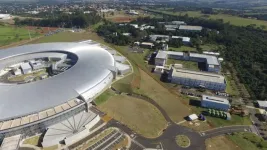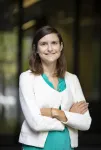(Press-News.org) Registrations are open for the São Paulo School of Advanced Science on 4th Generation Synchrotron Techniques (SyncLight 2024), to be held on October 14-25, 2024, at the Brazilian Center for Research in Energy and Materials (CNPEM) in Campinas, São Paulo state, Brazil
Reporters are invited reach the organizing committee through the email eventos@cnpem.br, for opportunities to visit the school and sessions.
Organized through the São Paulo School of Advanced Science (SPSAS https://espca.fapesp.br/home/) program, with support from FAPESP (https://bv.fapesp.br/en/auxilios/113004/), the event aims to gather young researchers from Brazil and abroad to discuss the recent opportunities offered by advanced experimental synchrotron techniques available at Sirius, the Brazilian 4th generation light source based in Campinas.
Over the past decades, synchrotron light sources have played a significant role in the development of modern natural sciences and engineering. With a wide range of experimental techniques available, synchrotron light sources have revolutionized the way scientists study and characterize materials in the fields of Physics, Chemistry, Biology, Health, Energy, New Materials, Environmental Sciences, and many others.
The School will benefit from a roster of speakers comprising highly regarded researchers in the field, such as Ana Diaz, from Paul Scherer Institut (Switzerland); Guimei Wang, from the United States National Synchrotron Light Source II; Hoi-Ying N. Holman, from Lawrence Berkeley National Laboratory's Advanced Light Source (USA); Tannaz Pak, from Teesside University (United Kingdom); Chris Jacobsen and Daniel Haskel from Argonne National Laboratory (USA); Kejin Zhou, from Diamond Light Source at the Harwell Science and Innovation Campus (UK); Tobias Schulli and Narayan Theyencher from European Synchrotron Radiation Facility (ESRF) in Grenoble, France, among others.
Approximately 100 applicants will be selected for the School – 50 from Brazil and 50 from other countries. The School’s target audience comprises researchers who have recently completed their graduation, Master’s/PhD students, and early career postdoc researchers. For two weeks, they will watch lectures covering a variety of topics including introduction to synchrotron accelerators and experimental techniques involving Sirius's beamlines.
The event’s program includes lectures, poster sessions, and guided tours at the facilities. Tutorials on experiments conducted, demonstrations on the control of the accelerators, as well as data analysis and simulations at the beamlines of the Brazilian Synchrotron Light Laboratory (LNLS), taught by LNLS researchers, are also planned.
Candidates should check the required documentation and apply for the School at the School’s website (https://pages.cnpem.br/synclight2024/registration/) until April 15, 2024.
Registration for SyncLight 2024 is free of charge and the event’s official language is English. Students who live outside São Paulo state may apply for financial assistance to cover travel and accommodation expenses.
END
A new São Paulo School of Advanced Science at the Brazilian Center for Research in Energy and Materials is receiving applications
SyncLight 2024 will discuss the recent opportunities offered by advanced experimental synchrotron techniques available at Sirius, the Brazilian 4th generation light source.
2024-03-26
ELSE PRESS RELEASES FROM THIS DATE:
Finance Professor at the Rotman School of Management Receives Best Young Researcher in Finance and Insurance Award
2024-03-26
Finance Professor at the Rotman School of Management Receives Best Young Researcher in Finance and Insurance Award
Toronto – Claire Célérier, an associate professor of finance at the University of Toronto’s Rotman School of Management, is one of two recipients of the 2024 IEF/SCOR Foundation for Science 2024 Best Young Researcher Award from the Scientific Council of the Institut Europlace de Finance (IEF). The other recipient is Paul Karehnke, an associate professor of finance at ESCP Business School.
The award was presented in recognition of their previous work and future potential for new research at the Financial Risks International ...
The fear of depression recurrence is potent but not universal, new Concordia research shows
2024-03-26
Clinicians treating patients who live with or survive serious diseases such as cancer are familiar with the concept of fear of illness recurrence (FIR). FIR has been associated with greater avoidance of illness reminders, including medical appointments, ignoring symptom changes, social withdrawal and increases in anxiety and decreases in quality of life and mood.
But as a Concordia research team led by Mark Ellenbogen, a professor in the Department of Psychology, points out in a new study published in the journal BMC Psychiatry, there is little research on FIR ...
The behavior of ant queens is shaped by their social environment
2024-03-26
The queens in colonies of social insects, such as ants, bees, and wasps, are considered the veritable embodiment of specialization in the animal kingdom. The common perception is that the queen's only task is to lay eggs – and that this attribute is an inherent trait, not influenced by external factors. In contrast, recent research undertaken at Johannes Gutenberg University Mainz (JGU) has demonstrated that in certain ant colonies the social environment can play a crucial role in shaping the ...
College of Sciences and Mathematics at Auburn University unveils proposed Centers and Institutes in Development
2024-03-26
On Monday, March 11, the College of Sciences and Mathematics (COSAM) held an event to announce the Centers and Institutes in Development (CIDs) at the Auburn University Alumni Center.
“I cannot tell you how absolutely excited to see this many COSAM faculty here today,” said Edward E. Thomas, Jr., dean of the college. “These new endeavors will help connect faculty in our college and with other colleges at Auburn to seamlessly collaborate on bigger and bolder research projects.”
The alumni center was packed with faculty from all of COSAM’s five departments.
“Today, we are here to ...
Case Western Reserve University awarded federal contract to develop and commercialize ‘live’ replacement joints
2024-03-26
CLEVELAND—About 32.5 million people in the United States and 500 million globally suffer from the degenerative joint disease known as osteoarthritis (OA), according to the Centers for Disease Control.
OA, in which tissues in the joint break down over time, is the most common type of arthritis—especially in older people. The usual treatments target pain-relief, often with prescription opioids or prosthetic surgery, such as knee and hip replacements.
Now, backed by an award from the Advanced Research Projects Agency for Health (ARPA-H), a federal agency within the U.S. Department of Health ...
Sleeping supermassive black holes awakened briefly by shredded stars
2024-03-26
A new investigation into an obscure class of galaxies known as Compact Symmetric Objects, or CSOs, has revealed that these objects are not entirely what they seem. CSOs are active galaxies that host supermassive black holes at their cores. Out of these monstrous black holes spring two jets traveling in opposite directions at nearly the speed of light. But in comparison to other galaxies that boast fierce jets, these jets do not extend out to great distances—they are much more compact. For many decades, astronomers suspected that CSOs were simply young and that their jets would eventually travel out to greater distances.
Now, reporting in three different papers in The ...
Researcher’s Microscale tech is chipping away at cancer, organ failure and neurological disease
2024-03-26
Arizona State University’s Mehdi Nikkhah, a biomedical engineer in the School of Biological Health Systems Engineering (SBHSE) and a member of the Personalized Diagnostics Faculty at ASU’s Biodesign Institute, is a pioneer in Organ-on-a-Chip (OoC) technologies.
For his outstanding contributions to engineering of biomimetic tissue-on-chip technologies and organoids for disease modeling and regenerative medicine, Nikkhah was inducted as a Fellow into the American Institute for Medical and Biomedical Engineering (AIMBE) on March 25 during the organization’s 2024 annual event in Arlington, Va.
AIMBE Fellows represent the top tier of biological ...
Study finds high prevalence of hidden brain changes in people with heart disease
2024-03-26
A new analysis involving over 13,000 people has found changes to blood vessels in the brain that can increase the risk of stroke and dementia are common in people with a range of heart conditions, regardless of whether they have experienced a stroke.
The new research, published today in Neurology®, the medical journal of the American Academy of Neurology, is the most comprehensive systematic review of ‘hidden’ brain changes in people with a range of heart conditions to date.
Lead author Dr Zien Zhou from The George Institute for Global Health said that identifying these ...
Joints that could heal themselves? Researchers could get there in five years
2024-03-26
Imagine a day when joints could heal themselves.
At the first inkling of a creaky knee, patients could get a single shot in the joint that would not only stop their cartilage and bone from eroding, but kick start its regrowth. In more advanced cases, that shot might also deliver a biomaterial repair kit to patch holes in tissue. If multiple joints ached, an annual IV infusion could ferry regenerating therapies to all of them at once.
This may seem like a dream to the 32.5 million people who suffer from osteoarthritis. ...
Safe viewing of solar eclipses
2024-03-26
On April 8, a total solar eclipse will pass over Mexico, the U.S., and Canada. This JAMA Patient Page describes solar eclipses and how to view them safely. END ...
LAST 30 PRESS RELEASES:
University of Oklahoma researcher awarded funding to pursue AI-powered material design
Exploring how the visual system recovers following injury
Support for parents with infants at pediatric check-ups leads to better reading and math skills in elementary school
Kids’ behavioral health is a growing share of family health costs
Day & night: Cancer disrupts the brain’s natural rhythm
COVID-19 vaccination significantly reduces risk to pregnant women and baby
The role of vaccination in maternal and perinatal outcomes associated with COVID-19 in pregnancy
Mayo Clinic smartwatch system helps parents shorten and defuse children's severe tantrums early
Behavioral health spending spikes to 40% of all children’s health expenditures, nearly doubling in a decade
Digital cognitive behavioral treatment for generalized anxiety disorder
Expenditures for pediatric behavioral health care over time and estimated family financial burden
Air conditioning in nursing homes and mortality during extreme heat
The Alps to lose a record number of glaciers in the next decade
What makes a good proton conductor?
New science reporting guide published for journalists in Bulgaria
New international study reveals major survival gaps among children with cancer
New science reporting guide published for journalists in Turkey
Scientists develop a smarter mRNA therapy that knows which cells to target
Neuroanatomy-informed brain–machine hybrid intelligence for robust acoustic target detection
Eight SwRI hydrogen projects funded by ENERGYWERX
The Lundquist Institute and its start-up company Vitalex Biosciences Announces Strategic Advancement of Second-Generation fungal Vaccine VXV-01 through Phase 1 Trials under $40 Million Competitive Con
Fine particles in pollution are associated with early signs of autoimmune disease
Review article | Towards a Global Ground-Based Earth Observatory (GGBEO): Leveraging existing systems and networks
Penn and UMich create world’s smallest programmable, autonomous robots
Cleveland researchers launch first major study to address ‘hidden performance killer’ in athletes
To connect across politics, try saying what you oppose
Modulating key interaction prevents virus from entering cells
Project explores barriers to NHS career progression facing international medical graduates
Jeonbuk National University researchers explore the impact of different seasonings on the flavor perception of Doenjang soup
Two Keck Medicine of USC Hospitals named Leapfrog Top Teaching Hospitals
[Press-News.org] A new São Paulo School of Advanced Science at the Brazilian Center for Research in Energy and Materials is receiving applicationsSyncLight 2024 will discuss the recent opportunities offered by advanced experimental synchrotron techniques available at Sirius, the Brazilian 4th generation light source.









